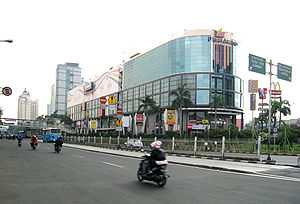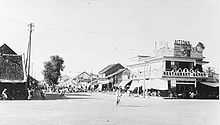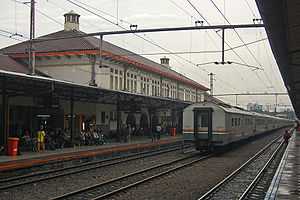Senen

Senen (meaning Monday in Indonesian) is one of the historic subdistricts of Central Jakarta, Indonesia. Its proximity to some of the historic areas of Jakarta such as Merdeka Square (formerly the Koningsplein) and Lapangan Banteng (formerly Waterloo Square) means that this area is also one of the historic areas of Jakarta. Some of the important landmarks of the Senen subdistrict are the Museum of Indonesian National Awakening (formerly the STOVIA medical school) and the Faculty of Medicine of the University of Indonesia.
Senen subdistrict is roughly bounded by a railway line to the east and Ciliwung River to the west. The area is mainly served by Senen railway station and Senen bus terminal which is served by both Transjakarta and Kopaja bus services. Some of the important roads of the area are Kramat Raya Road (the main road that formerly linked Jakarta with Jatinegara) and Senen Raya Road (the focal point of the Senen market).
History

The historic part of Senen is mainly concentrated on the Senen administrative village. Senen was developed in 1733 by Dutch entrepreneur Justinus Vinck after the Dutch government built the new town, Weltevreden, in south of Batavia. Besides Senen market in the east, Vinck also built Tanah Abang market in the west. The two markets are linked by Kwitang street and Kebon Sirih street.
On 19 November 1919, the government built the CBZ (Centrale Burgelijke Ziekenhuis) in Salemba, southern area of Senen Subdistrict which was renamed Cipto Mangunkusumo Central Hospital following the nation's independence.[1]
During the 1960s and 1970s, many artists and poets began their career in the Planet Senen youth center, among them being Benyamin Sueb, Bing Slamet, and Misbach Yusa Biran. On 15 January 1974, students demonstrated against the government’s policy regarding the role of foreign investment in Indonesia. Beginning in front of Senen market, the demonstration led to a series of riots known as the Malari incident.
Trade center

Today Senen market is one of six Jakarta trade centers along with Glodok, Mangga Dua, Jatinegara, Tanah Abang, Pasar Baru and Blok M. In 1970, Ali Sadikin, the governor of Jakarta, built Proyek Senen.[2] Along Kramat Raya street, vendors of Minangkabau descent can be seen selling a variety of Minangkabau cuisine. Along Kwitang street lies Jakarta's largest book market.
In 1990, the government built a modern shopping center, the Atrium superbloc which before 1997 Asian financial crisis hosted the international brand of Yaohan and Mark & Spencer as its anchor tenant.
Planet Senen Youth Center

Planet Senen Youth Center is located next to Pasar Senen station and across from the Senen bus terminal. The place was a meeting place for young poets and artists in the 1960s. The center was later inaugurated by the governor of Jakarta, Ali Sadikin, on 27 August 1974, as part of his efforts to improve the area's condition, known at the time for its high crime rate and prostitution. It was named "Planet Senen" because during the time of its construction, there were many round buildings in the area. Today the center has a theater and an indoor sports facility.
Historian Alwi Shahab said the Senen prostitutes were later moved to Kramat Tunggak, North Jakarta, by governor Ali Sadikin.[3]
Later in the 1970s, Planet Center popularity began to fade as most poets and artists started to go to the nearby Taman Ismail Marzuki (TIM) arts centre on Jl. Cikini Raya in the Menteng district.[3]
In 2005, the city administration planned to revitalize the whole Senen commercial area, including the bus terminal and station. However, the revitalization plan has not begun.[3]
Kelurahan (administrative village)
The subdistrict of Senen is divided into six administrative villages (kelurahan):
- The location of the Kwitang book market.
- Kenari – area code 10430
- The southernmost area of Senen Subdistrict and the location of the University of Indonesia and Cipto Mangunkusumo Hospital.
List of important places

- Cipto Mangunkusumo Central Hospital
- Faculty of Medicine of the University of Indonesia
- Museum of Indonesian National Awakening (formerly the STOVIA medical school)
- National Library of Indonesia
- Pasar Senen Station
- Planet Senen Youth Center
- Senen Shopping Centre (consists of Pasar Senen ("Senen market") and Plaza Atrium Senen)
- St. Carolus Hospital, Paseban administrative village
- Sumpah Pemuda Museum
- Vincentius orphanage (circa 1855)
- The Wayang Orang Bharata theatre which stages Wayang orang shows on most Saturday nights
References
- ↑ http://rscm.co.id/pages.php?id=1#sejarah
- ↑ http://www.arsitekturindis.com/?p=257
- ↑ 3.0 3.1 3.2 "Planet Senen Youth Center in need of a revamp". The Jakarta Post. Retrieved 18 February 2010.
| ||||||||||||||||||||||||||||||||||
| ||||||